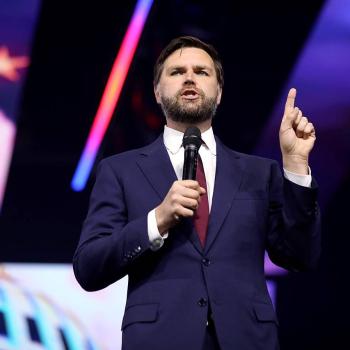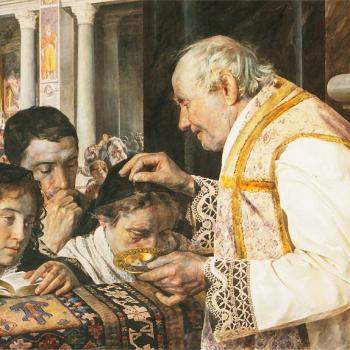This is the edited text of a talk I gave yesterday, November 8, at the Regional Assembly of the Solanus Casey Region, Secular Franciscan Order.
The regional council asked me to speak today on evangelization through peace and justice. This ties in well with the call to a New Evangelization that Pope Benedict XVI made a few years ago. Quite fortuitously, today [11/08/2014] is a very unhappy anniversary, one which provides a useful example for my talk today. On November 8, 2013, Typhoon Haiyan hit the Philippines. Haiyan was the most powerful typhoon to ever hit the Philippines, and in fact it stands as the most powerful storm on record: a Category 5 hurricane with top wind speeds of 195 mph and gusts up to 235 mph. By comparison, when it made landfall in Louisiana, Hurricane Katrina was a Category 3 storm with sustained winds of 125 mph. The island of Leyte was devastated with more than 6,500 people killed and 80,000 homes destroyed.
There was an immediate international response: in the two months after the disaster governments pledged more than 500 million in relief aid. Non-governmental aid organizations, such as Catholic Relief Services, also responded with aid for both immediate relief and long term reconstruction. This was a timely and important response, but now, as I shift gears, please keep the example of Typhoon Haiyan and the Philippines in mind.
The goal of my talk is to show you that the work of peace and justice, which is the focus of my ministry as JPIC chair, is grounded in Catholic social teaching and is an integral part of the new evangelization. But what is the new evangelization? The USCCB has an excellent introduction to this topic and they explain it and its connection to social justice in this way:
The New Evangelization calls all followers of Christ to be formed in the faith, celebrate the faith, and be witnesses to the ends of the earth, proclaiming the Good News to all people everywhere, starting with those in our own Church.
The work of the Church is to bring all people into relationship with God, and also to transform and sanctify the society in which we live (U.S. Catholic bishops, Disciples Called to Witness: The New Evangelization). Thus, “the Church teaches that social justice is an integral part of evangelization, a constitutive dimension of preaching the Gospel, and an essential part of the Church’s mission” (U.S. bishops, Communities of Salt and Light). (Emphasis added.)
This is a very dense and powerful statement: every sentence, every phrase is rich in meaning. Let’s try to unpack, especially in light of the Rule of the Secular Franciscan Order. As Franciscans we are called “to observe the Gospel of our Lord Jesus Christ” (paragraph 4), to become followers of Christ using the example of St. Francis as our model. We are to go “from gospel to life and from life to gospel” (para. 4): we are to be more fully formed in the faith and to be witnesses of it to the ends of the Earth, particularly in our daily lives. Our witness is to start with our own: our families, our parishes, our fraternities, but there are no boundaries. There is no place in our lives where we can draw a line and say that beyond this the gospels do not apply.
Our proclamation of the gospel has many parts, but it should always be grounded in Christ: as St. Paul said, “we preach Christ crucified” (1 Cor 1:23). As our bishops made clear, a major part of this mission is to work to reshape the world, to “transform and sanctify” it, “to create conditions of life worthy of people redeemed by Christ” (para 13). The people redeemed by Christ has no limitations, no boundaries: everyone is redeemed by Him. We are “called to build a more fraternal and evangelical world so that the kingdom of God may be brought about more effectively” (para 14). In other words, to preach the Gospel to all nations, we have to do more than, as some of our evangelical brothers and sisters do, hold up signs at football games that say “John 3:16”. Later on, as John recounts, Jesus tells us disciples, “Love one another as I have loved you” (John 13:34). This is the sacrificial love that led Jesus to die for us on the cross. To imitate this sacrificial love we need to love and serve the world, or more precisely, our brothers and sisters throughout the world. As Carolyn Woo, CEO of Catholic Relief Services put it in a talk on the new evangelization, “Faith compels action.”
What are “conditions of life worthy of people redeemed by Christ?” What is a “more fraternal and evangelical world?” These are the questions that Catholic Social Teaching tries to answer. CST provides a comprehensive vision of how the world should be. It does not specify particular solutions and it is not partisan: it does not tell us specific political parties to support. Rather, it provides a foundation by laying out criteria for determining what is good and just in a society and what is not. We could spend days talking about CST, but I was pushed to summarize it in one sentence, I would quote Dorothy Day, who in turn was quoting her colleague Peter Maurin, who said that the mission of the Catholic Worker was “to bring about a society where it is easier to be good.”
What is a world like where “it is easier to be good“? It would be a world without poverty and hunger and malnutrition, a world where mothers do not regularly die in childbirth. It is the kind of world we want for ourselves, our families and our children: good jobs for those who want to work, a roof over their heads, food on the table, an education for the children. Can we ever create a world like this? Yes and no: in the end we cannot make utopia—fallen man lives in a fallen world, and only on the last day will God make all things new. (cf. Rev. 21:5) Indeed, some more pessimistic people will quote Jesus, saying “the poor will always be with you” (Mark 14:7). But Jesus did not mean that this as an excuse for inaction. Rather, it means that our hearts should be set on the Kingdom of God, and our actions should be directed towards realizing it now, however imperfectly. We are in it for the long haul, working “to build a more fraternal and evangelical world.”
What must we do to achieve this? There are three steps. The first is to see the world as it really is, to really see our brothers and sisters who are poor. Sometimes this is easy: the media provided daily coverage of the tragedy of Typhoon Haiyan for days afterwards. But often we give ourselves permission to no see them—the poor, the marginalized, the jobless, the homeless, the prisoner—especially when they are closer to home. In every time and place, people have bought into a vision of the way the world ought to be, whether the “glory of Rome” or the “Home of Free and Land of the Brave” that is America. And part of of this myth is to ignore the gaps and failings.
Here is one particularly graphic example: New Canaan, CT, is one of the richest towns in America, making it one of the richest communities in America. Back in 2006 the New Canaan Public Schools decided to stop offering free lunches to students who qualified, presumably because so few students were taking advantage of this federal program. It is not that there were no students: there were a few. But apparently they were worth maintaining the program (which comes with a fair amount of paperwork and administrative overhead). In other words, they were giving themselves permission to not see the poor in their midst. They were like the rich man who daily stepped over Lazarus (Luke 16:19) but did not see him, except perhaps as an obstacle to get past. (In fairness to New Canaan I must note that sometime after 2011 they reinstituted free lunches.)
The second thing we need to do is understand more fully the circumstances of our brothers and sisters. We need to ask “why are they poor?” and not settle for facile or superficial answers. In particular, we need to look beyond individuals and look at the social structures around them. What social forces contribute to their situation? What institutions and forces prevent them from using their own talents and resources from getting ahead? What in their world needs to be “transformed and sanctified“?
The third thing we need to do is to act on what we have learned. Such action must be twofold. The first entails personal charity and sacrifice on our part. To the best of our abilities and resources, we need to carry out the corporal works of mercy: feed the hungry, give drink to the thirsty, clothe the naked, shelter the homeless, tend the sick, visit those in prison, bury the dead. This is our witness to the gospel. This is the action that faith compels us to. And this is how the world will see that we are Christians and be able to say, “see how they love one another!” (cf. John 13:35).
But beyond charity we must engage in prophetic witness. We must be the voice for the poor and marginalized; we must ask why our world is the way it is and why it is so hard for men and women “to be good“. In this we will follow the Old Testament prophets. They regularly excoriated the people of ancient Israel for either ignoring the poor in their midst or, worse, for actively exploiting them. Consider this passage from Isaiah, one of dozens I could have chosen:
Woe to those who make unjust laws,
to those who issue oppressive decrees,
to deprive the poor of their rights
and withhold justice from the oppressed of my people,
making widows their prey
and robbing the orphan. (Is 10:1-2)
In denouncing laws and decrees, the prophet Isaiah is not just condemning particular individuals: he is chastising a society for allowing this to happen.
With these three steps in mind, let me return to the example of Typhoon Haiyan. As I said, in the immediate aftermath of the typhoon many nations and NGOs pledged more than 500 million dollars in relief and reconstruction aid. All good and important. But is this generous response enough? Is there more going on that underlies their plight? The Philippines were poor before the storm: Typhoon Haiyan took a bad situation and made it catastrophic.
There are two issues (among many) that I want to highlight. The first is the Philippine’s external debt, much of it contracted by the corrupt President Ferdinand Marcos. During the period in which governments were pledging relief money, roughly from November 8 to the end of the year, the government of the Philippines paid out 900 million dollars in hard currency to foreign banks and governments to service its external debt. In 2014, while still struggling to rebuild after the typhoon, the Philippines will spend more than 6.5 billion dollars on debt repayment. And despite this crushing burden, the World Bank announced that it would “help” the Philippines by loaning (not giving) it 1.9 billion dollars. Confronted by this you must ask: is this just? Does this reflect a society that has been “transformed and sanctified” by the gospel of Christ?
The second issue is related to the ferocity of the storm. As we know living in New England, there is no predicting the weather. We can, however, study the climate, the long term trends in the weather, and see the patterns that have emerged. In the Pacific the trend is towards more and more powerful storms. The reason for this trend is clearly understood: climate change induced by the actions of humanity. We cannot blame Haiyan itself on climate change, but we can say for certain that climate change will make this and other disasters more frequent and more catastrophic.
Since the start of the industrial revolution, atmospheric CO2 levels have increased by approximately 1/3, from 280 ppm to about 395 ppm. This increase has been an unforeseen consequence of the industrialization that underlies western civilization. It is part of the price we have paid for the wealth of western nations: a wealth that has made our current lifestyles possible. (In passing, let me note that I appreciate this lifestyle: I like central heating and indoor plumbing. I am typing this article using cutting edge computer technology.) However, this price is not paid equally by all. Just as in our own country pollution more often affects the poor and marginalized, throughout the world the price of climate change—worsening storms, flooding, disruptions in food production—will be born disproportionally by poor nations such as the Philippines. What, in justice, do we owe these countries? What must be done to compensate them for the harm that will befall them through no fault of their own?
This question must be seen as a social question: it is too big, too complex, to be addressed solely by the actions of individuals. And it cannot be seen as a matter of charity—what we in the West owe these countries, we owe out of justice, and not as a matter of charity. (Think of the words of Pope Gregory the Great: “When we attend to the needs of those in want, we give them what is theirs, not ours. More than performing works of mercy, we are paying a debt of justice.” Compendium of the Social Doctrine of the Church, 184) But as individuals we can give witness. We can work to change the social structures and thereby help “build a more fraternal and evangelical world“. It is our mission, as Catholics and Franciscans, to “transform and sanctify” the world for Christ.












